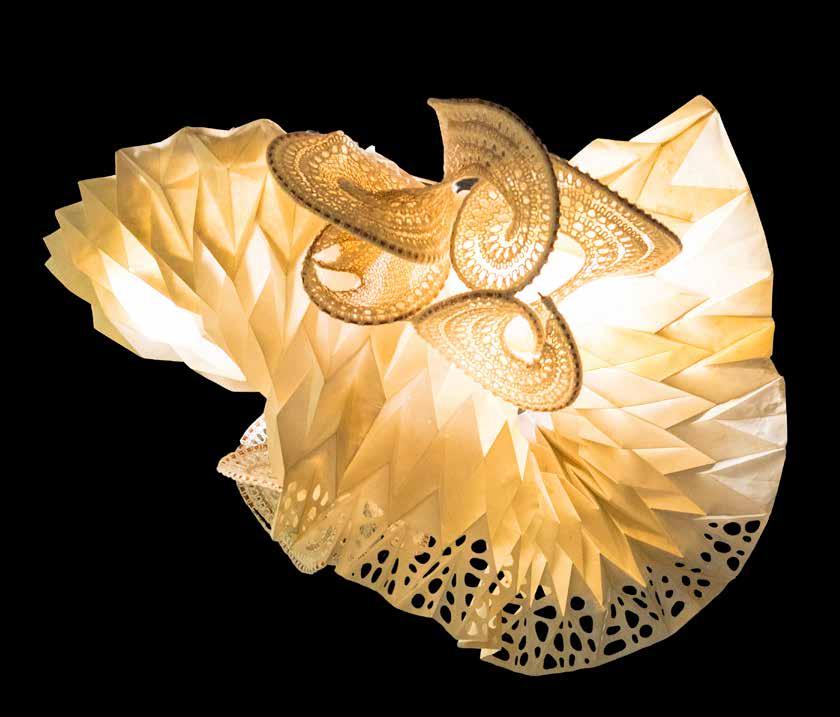INDIAN crafts interiors



Traditional craftsmanship in India is as old as and can be traced back to the beginning of civilization in the subcontinent. Locally available materials were used by master craftspeople in order to create objects of value used for a variety of purposes. Despite the wide range of crafts practised in India since antiquity, contemporary discourses on design have been slow to recognize the potential of this heritage, with only a handful of designers incorporating traditional crafts in their vision. With many such crafts now disappearing owing to modern methods, there is an urgent need to present a design-oriented perspective on crafts, with a focus on sustainability for a symbiotic and meaningful future for both.
It is not enough to treat craft as an afterthought, but rather, the best results are obtained when craft itself forms the DNA of the design. This volume aims to create a lavish showcase of the possibilities of Indian crafts being used in expressive, practical and contemporary ways within interior spaces. Organized by material, the contributors take us through the wide range of regional craft variations as well as outstanding examples of design solutions that utilize these crafts. The result is a volume that functions as a reference resource, inspirational “lookbook,” and index of practitioners. With insightful essays on stone; grass, coir and natural fibres; wood; textiles; bamboo and cane; glazed ceramics and terracotta; surface decoration; metal; and glass and mirror-work by various pioneers as well as stunning visuals, this is an indispensable volume for students and practitioners of design.
With 288 photographs and a map.
front cover:
Sanjhi panels/Studio Lotus (see p. 77 and p. 260)
back cover: Dyad/Oritecture (see p. 140 and p. 260)


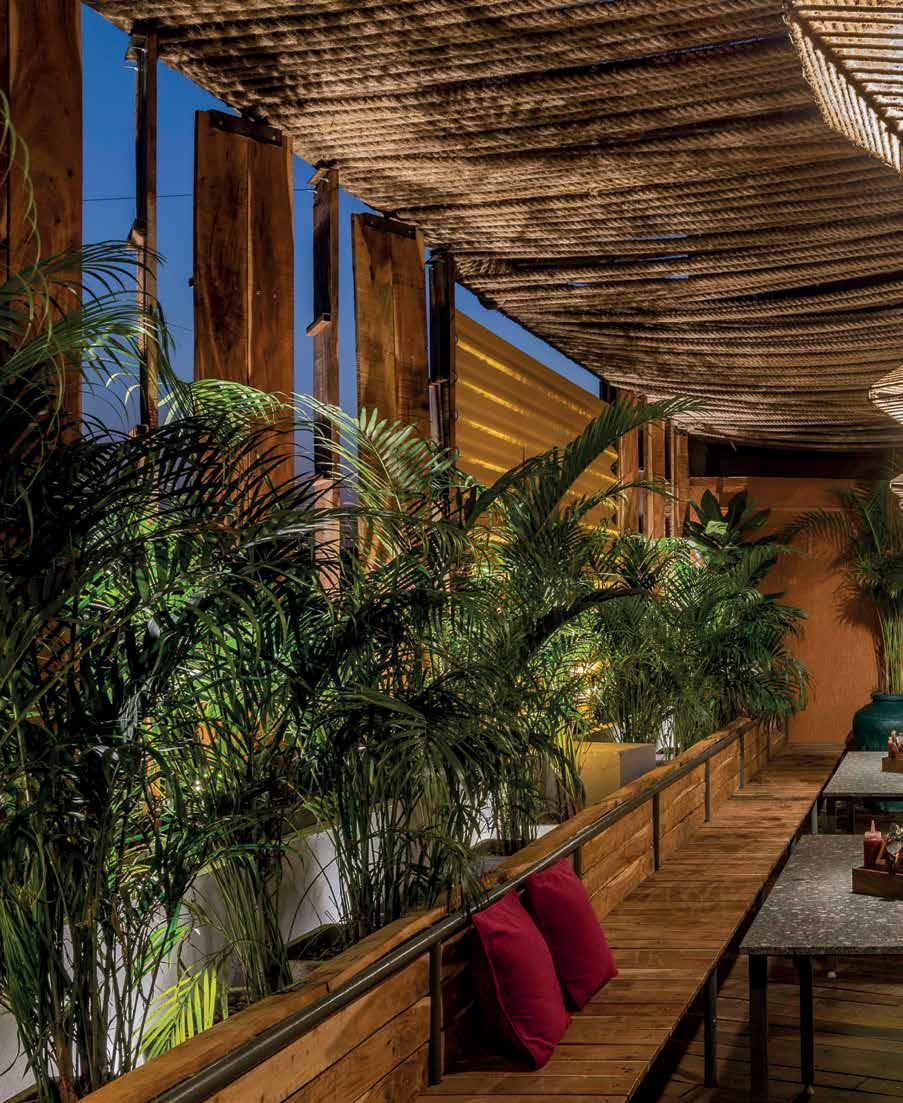
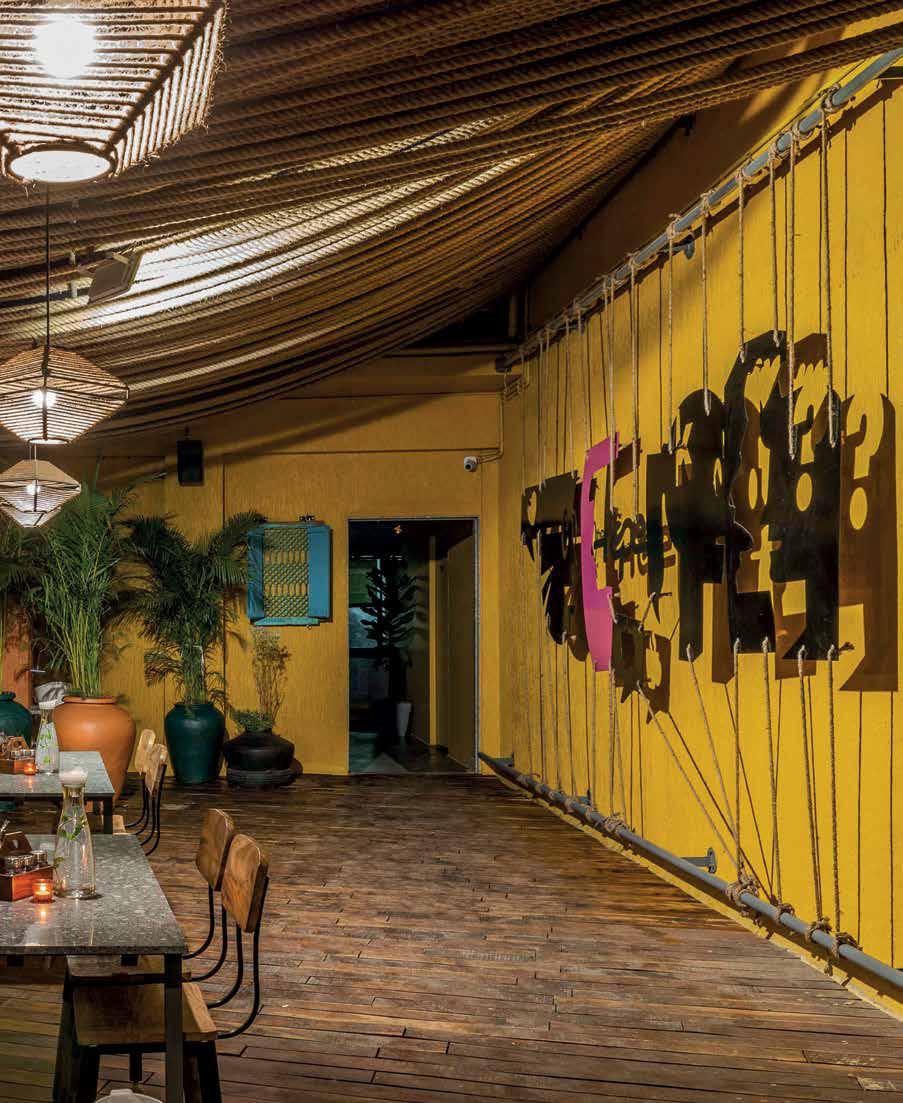
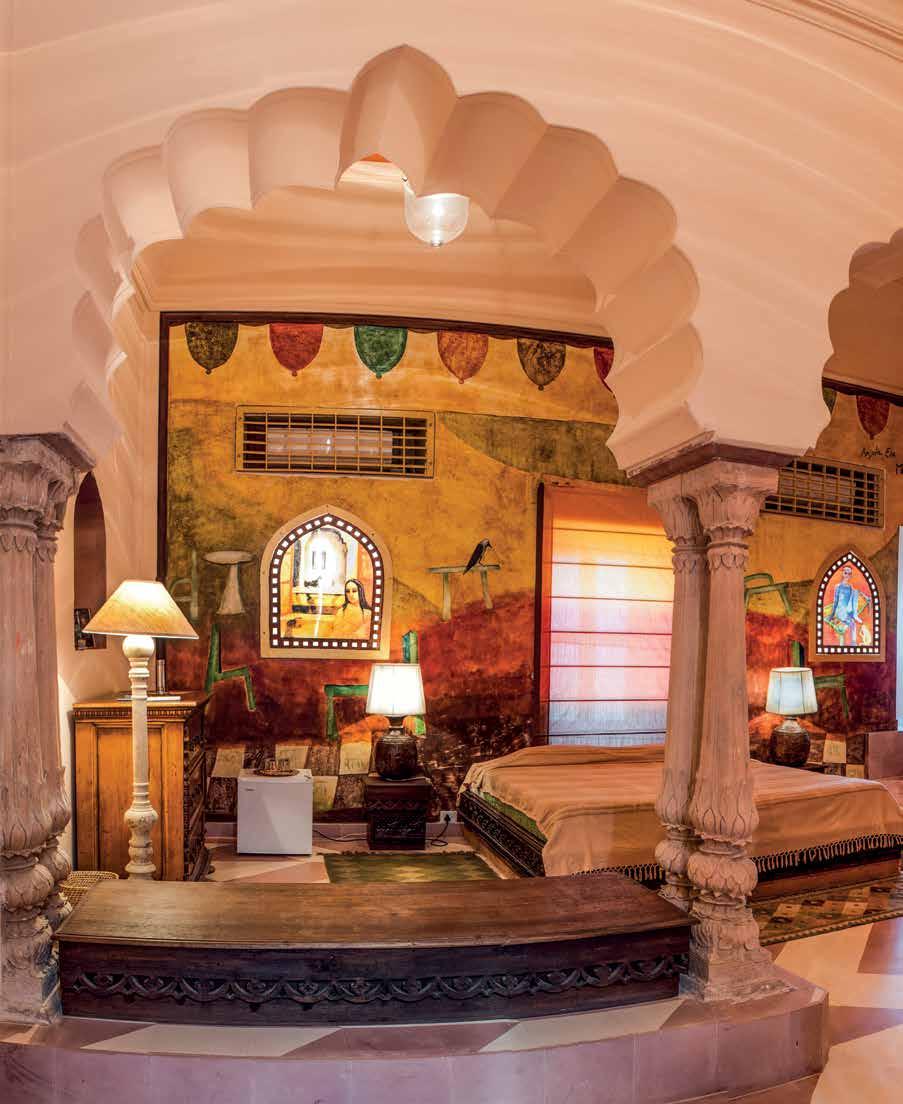

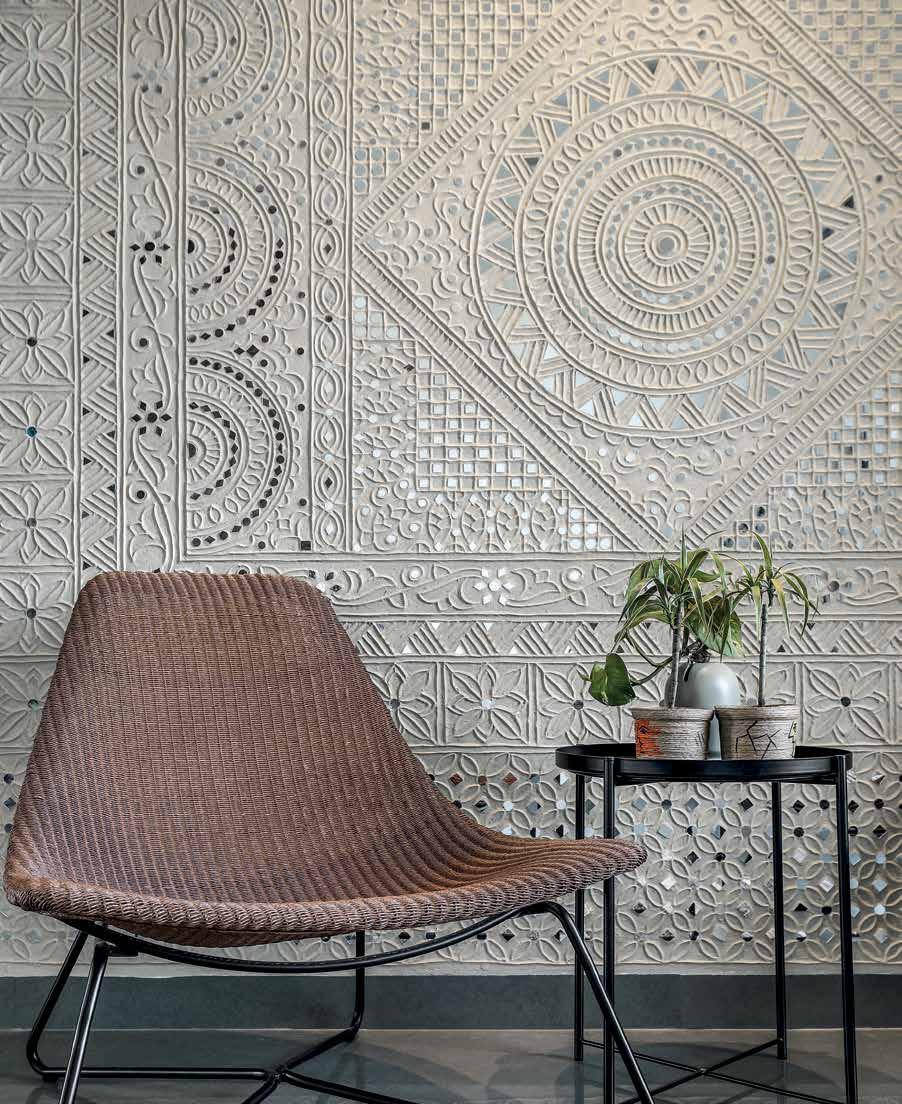
Jaya Jaitly
Asha Sairam
Kristine
Aman
Neelam Chhiber
Rebecca Reubens
A. Balasubramaniam
Jaitly
Abdul Karim
Kasliwal
Rathi
A large ritual bell metal lamp takes pride of place in the home of the maker.
Image credit: Dastkari Haat Samiti
The “wonder” that was India is still the great wonder that India is! Especially if one sets aside any arrogance or condescension while arriving at the doorstep of a craftsperson. An encyclopaedic knowledge linked to craft skills and an awareness of all the nuances and unpredictability of their materials still lives on, intuitively awake and instinctively drilled into their DNA. After all, India is the world’s only civilization, of its scale, to remain continuously alive through the millennia. Other ancient cultures, which began some three millennia later, also ended much earlier than ours because they had built false social momentums geared only to power, greed and materialism. Having not understood the ephemeral in life, the Egyptians even put objects in the sarcophagi for use in the afterlife, while we turn life effortlessly to ash and mingle it with the eternal elements of fire, earth and water.
The most remarkable aspect of India’s craft skills and their practitioners is their adaptability to engage with and enhance the work of contemporary designers who wish to make their creative output both aesthetic and uniquely Indian. The term “designer” applies here not merely to architects and interior designers but to fields as widespread as tourism, graphic design, fashion, and intermediate and appropriate technology, and can play a strong part
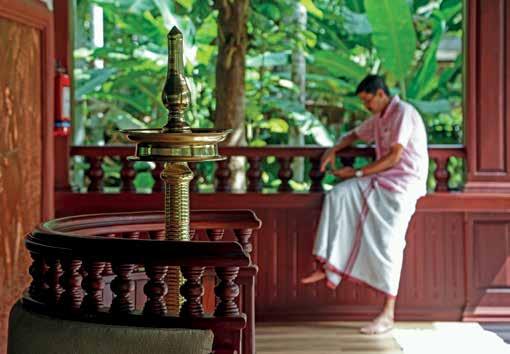
in the combination of economic and cultural oases. Unlike heavily industrialized countries, more than one hundred craft skills are still alive in India, and, when infused with aspiration and accessibility into modern environments, they are thriving and continuously morphing, often in the hands of able professionals in urban design offices and studios everywhere.
From a predominantly agrarian society, India is slowly changing and layering, rather than discarding, its old ways of organic farming and manual work, even modernizing traditional wisdom in health and medicine through technology and science. The beliefs that natural indigo dyes are good for the skin or that turmeric is a textile colourant as well as an anti-inflammatory agent in food or that, altogether, natural dyes are better for the environment—are being readily accepted internationally. Traditionally, Indian women are experts at recycling, renovating and repurposing. Their quilting of frayed fabrics in kanthas has become an art form, transforming a simple coverlet into a storytelling spread in fine embroidery, the aesthetics of which designers often cannot match. These constitute a valuable knowledge base that can transform the world of design. Particularly in the use of natural materials in the interiors, India’s rural structures employ a mixture of clay and lime, while larger palaces and forts have been generous with stone, which acts as a cooling agent in desert areas, with lattices further allowing in breeze. Narrow, shallow water channels ran along corridors to provide a cooling system. Contemporary architecture and interiors in Kerala and Goa employ many old techniques in brick, tile and wood, with elements of old balconies as a tribute to a fast-disappearing culture. Even the burnished lime walls, araish, or floors made with crushed eggshells in the mix, make sporadic appearances.
Earlier, crafts skills were employed in interiors of homes to provide many necessary elements of utility. Care needs to be taken today to not make these merely decorative because, in India, any crafted object or aspect of an interior environment has always had a deeper meaning, whether practical or ritualistic. The Indian-ness would become superficial and hollow if designers ignored this aspect.
In Karnataka, there is a craft skill in which rosewood is carved and inlaid with patterns, often comprising up to 45 different types of wood, such as mango, jackfruit and rubber, etc. Coconut wood is being used by contemporary architects as outer wall cladding or shutters. Mango wood, which is one of the easiest to obtain, is now being processed through technology to make good quality furniture. Similarly, natural materials such as jute and a variety of other wild and cultivated grasses today provide inspiration for cooling partitions and wall cladding. Indian interior designers have great opportunities now to offer truly ecofriendly, cost-effective, natural environments for comfort, ecological and aesthetic reasons, with the added rare element of locally available hand skills.
The crafted elements that are unique to India and some South Asian countries offer the true meaning of “bespoke” in any field of design because they can make the client feel special and pampered. While each interior is differently imagined according to the interaction between the interior designer and the client, when this is enriched through the third element, of a craftsperson interacting intimately with the designer, the palette of possibilities increases. All designers chase innovation, and this is most achievable when working with skilled craftspeople.
Handmade tiling for floors, textures for surfaces or furniture, custom-woven textiles, lamps individually fashioned out of pliable bamboo or even handmade paper: these are

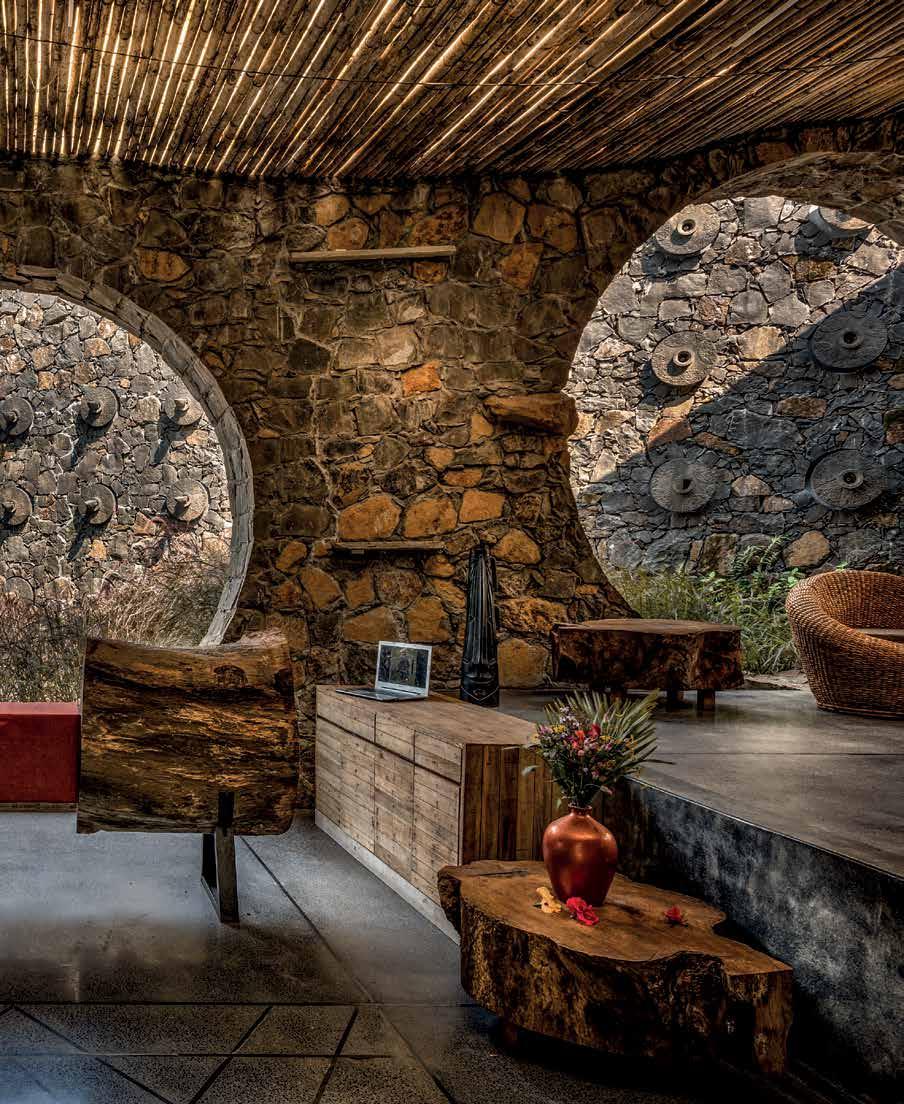
Natural stones can be used in a variety of ways for both interior and exterior purposes, such as aesthetics, structural solutions, flooring and surface treatment. Stone is greatly valued for timelessness and is a classic material that can make any space look more elegant and luxurious. Flooring is done using a combination of locally available stones of different quality and hardness to achieve interesting and colourful compositions. Surface treatment is done by either carving or cladding the surface with
stones of different patterns and colours. Techniques include cutting, carving and polishing of stones, which is achieved manually or through machines.
Inspiration: The idea of sustainable and traditional design processes inspired us to use stone craft in numerous projects. Traditional houses and havelis display beautifully carved columns, niches, brackets and various other elements. These elements have been contemporized in a coherent manner in an attempt

to meet the agelessness of traditional architecture.
Sustainability: Designing with stone presents an exciting array of options. Moreover, natural stones are durable and their process of installation is harmless to the environment. Establishing the use of stone craft in designing processes ensures the continuity of this traditional method and the survival of the skills of the craftsmen, which have been passed down for generations.
Material: Granite, limestone, sandstone, marble, slate, gneiss, serpentine Technique: Carving, cutting, grinding and polishing
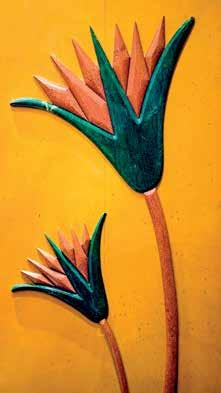
Source Region: Gujarat and Rajasthan, India Studio: Abhikram Architects, Panika Crafts and Technologies
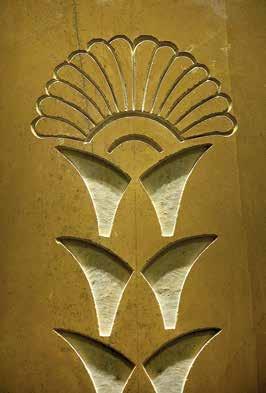
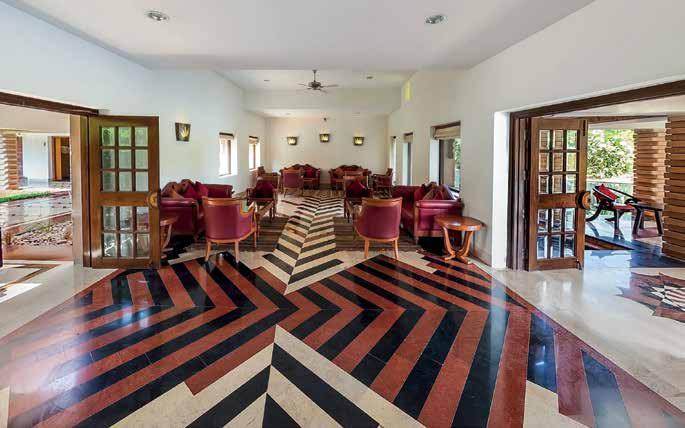
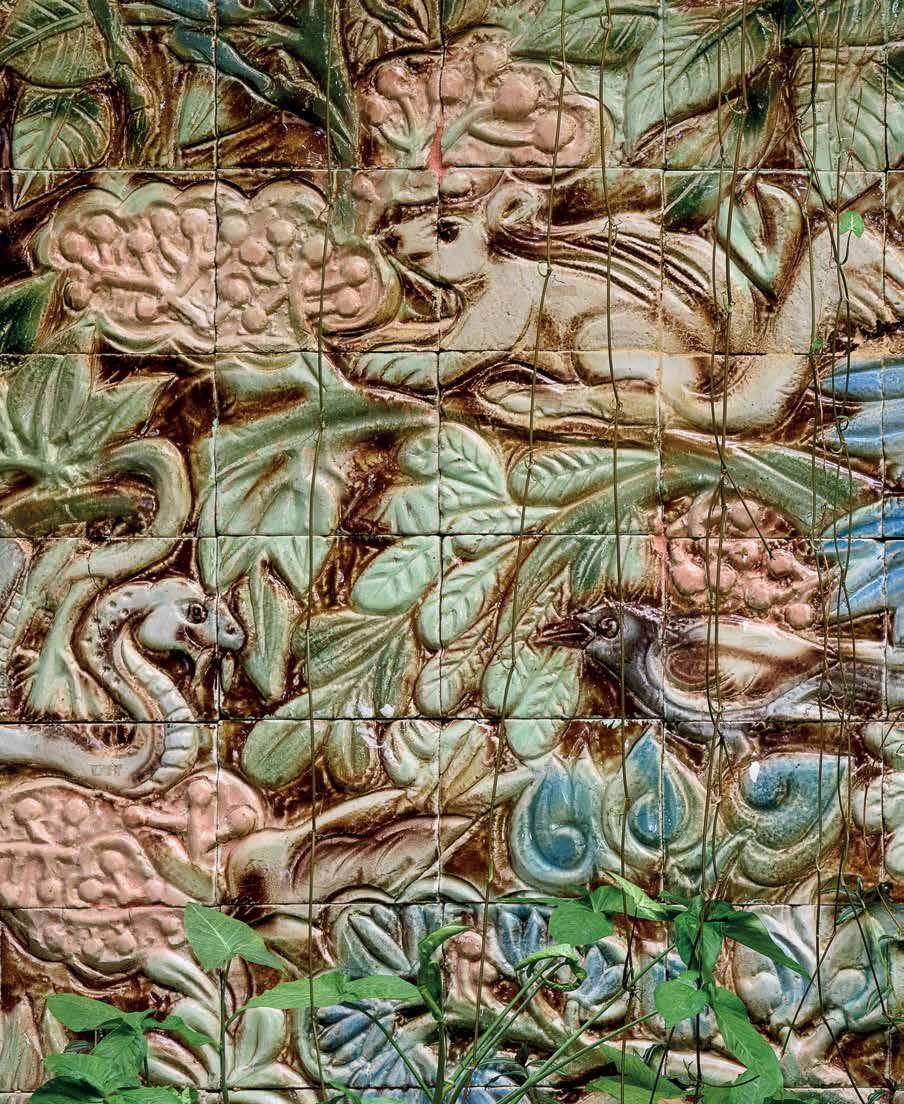



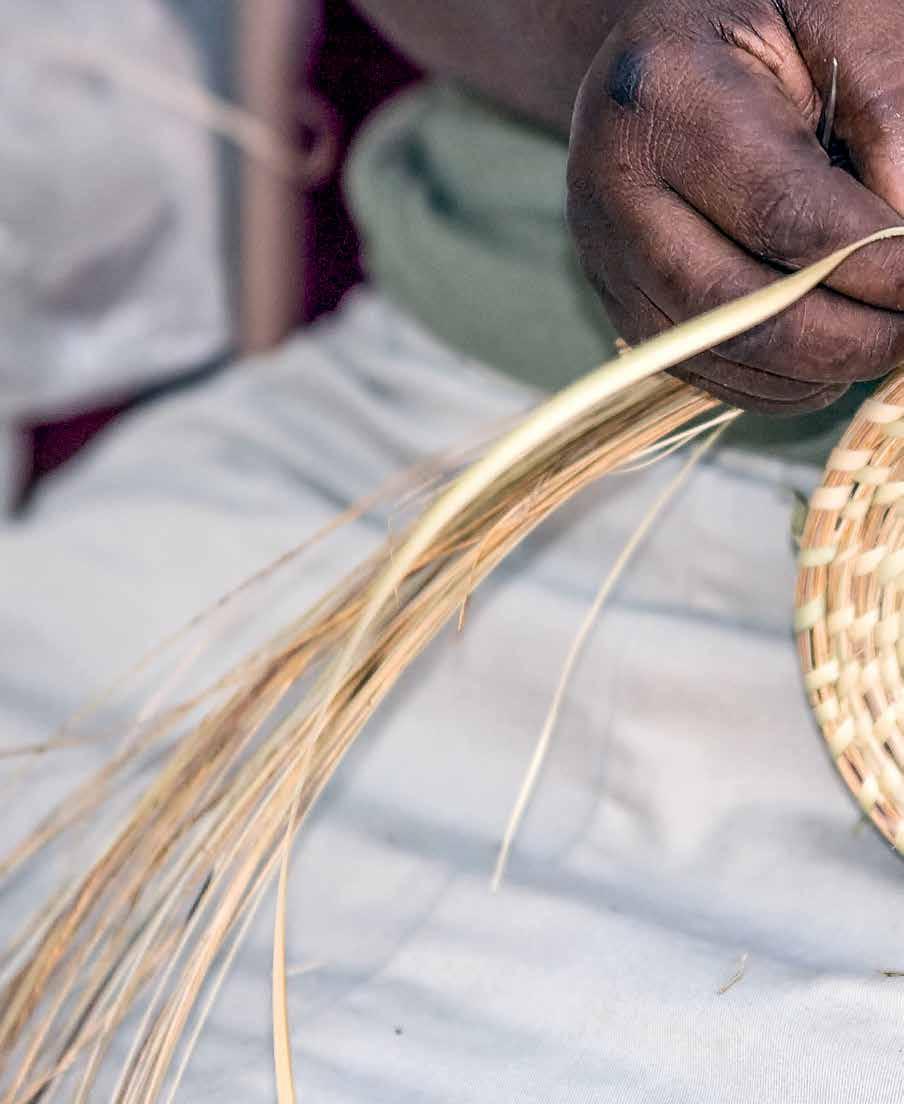
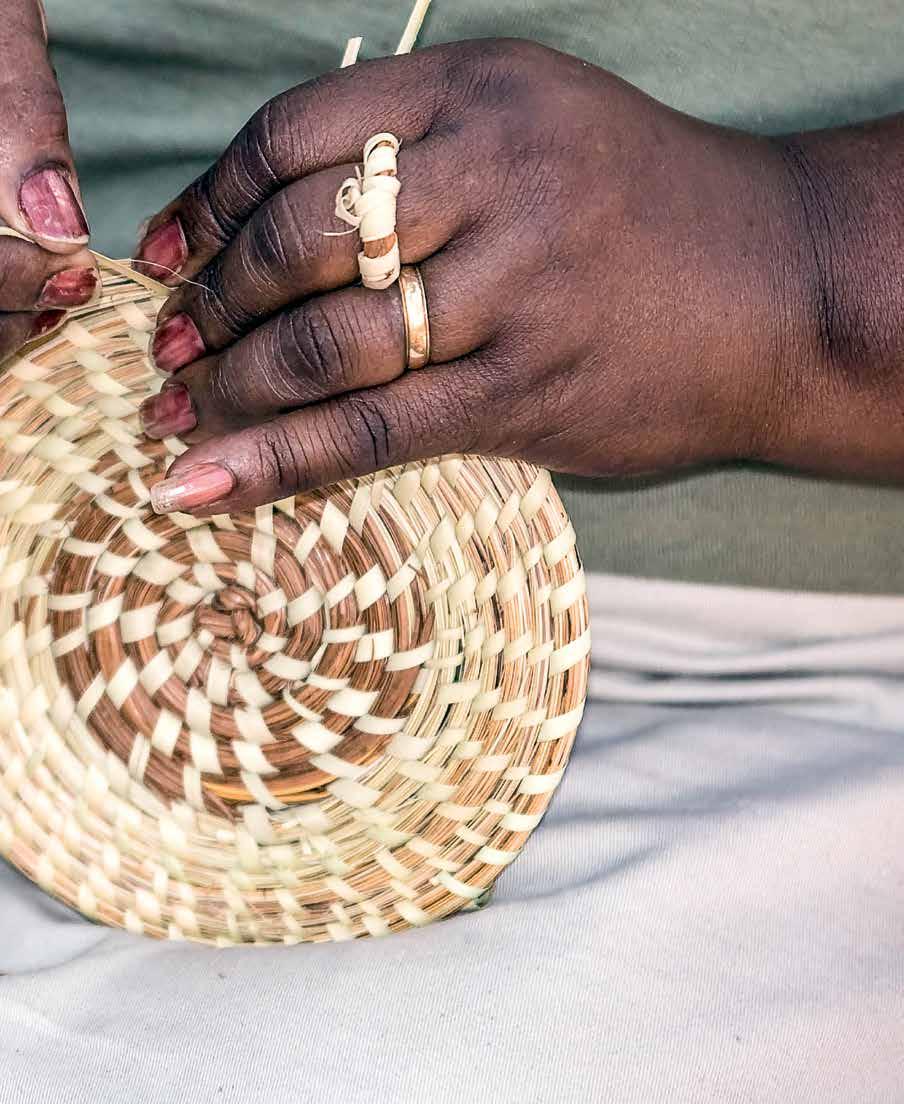
For this project, the objective was to use the materials not as add-ons but as part of a seamless experience. Mud was stabilized and finished with lime wash. Bamboo was treated for longevity and finished with external-grade PU coat, and the furniture joints were bound with cane for strength and aesthetics.
Inspiration: The five elements—Earth, Air, Fire (Sun), Water and Space—were the main inspiration for the design and construction of spaces for peace and harmony in this project. The idea was to make the ambience of the house dissolve in the background without obstructing, as is the case with most of our traditional spaces.
Sustainability: Mud and bamboo are among the most sustainable materials to be used in buildings and interiors. Bamboo is a highly resource-efficient material due to its rapid growth and is extremely versatile in usage. Moreover, its use also supports vulnerable bamboobased communities, thereby conforming to the three Ps—People, Planet and Profit.
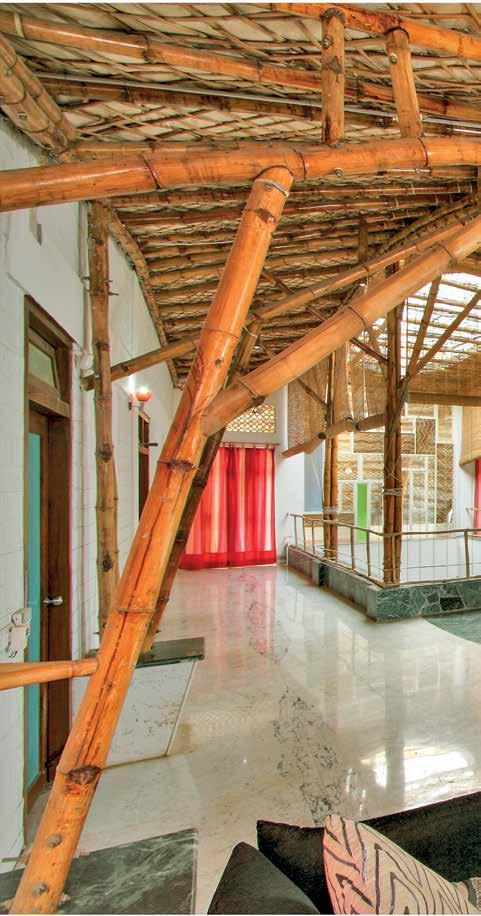
Material: Bamboo Technique: Traditional processing and construction
Craftsperson (s): Gopal Kr Tanti, Syed, Uttam and Anandilal Marandi
Source Region: Karnataka, India Studio: Manasaram Architects
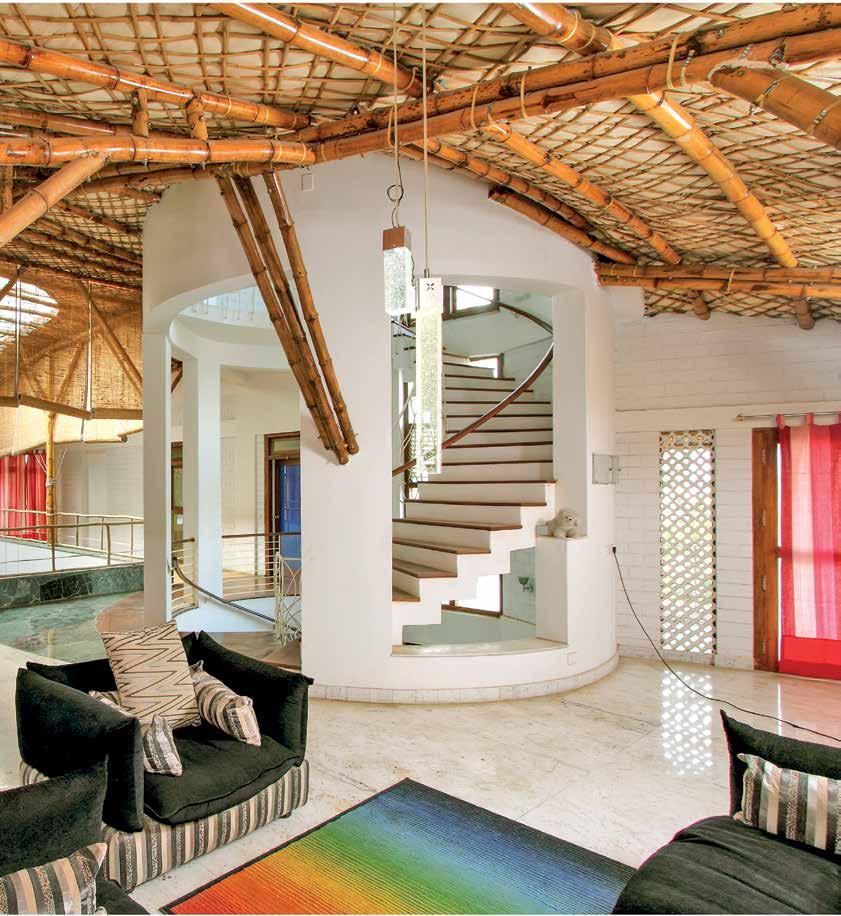

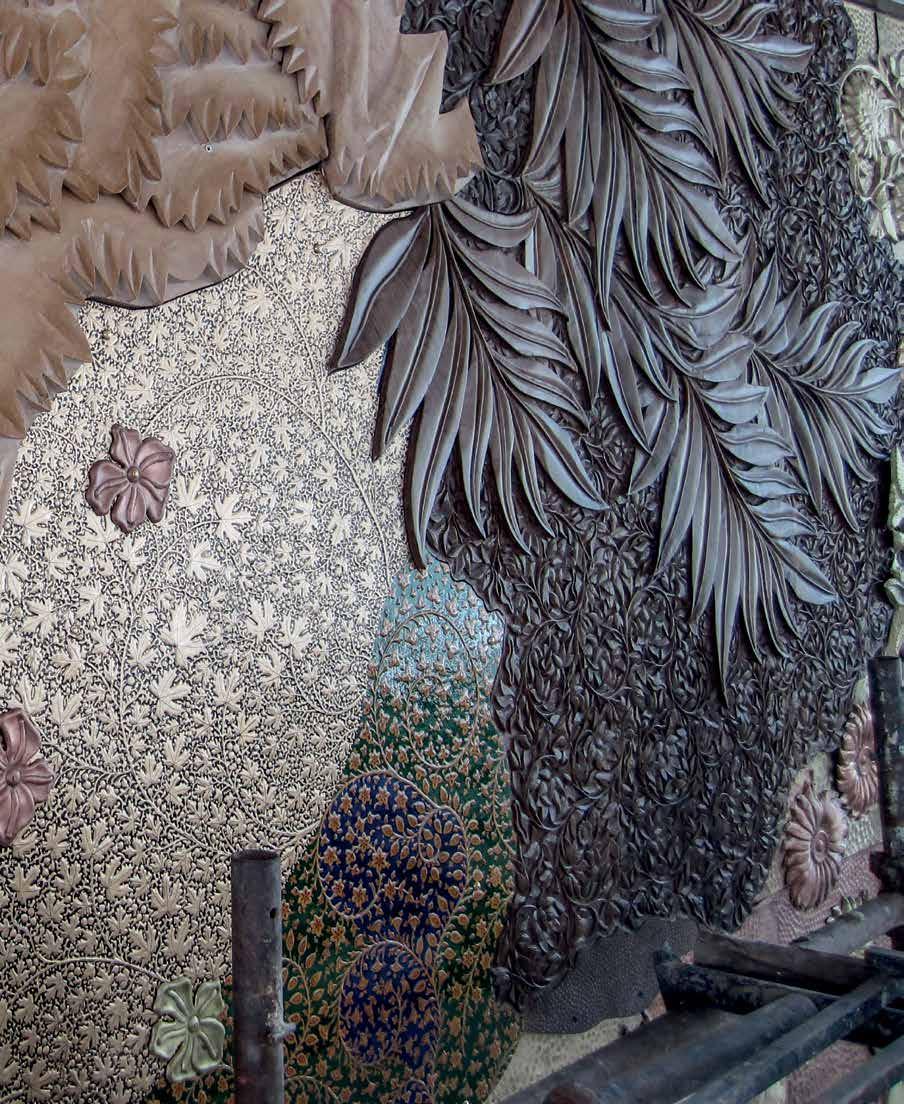

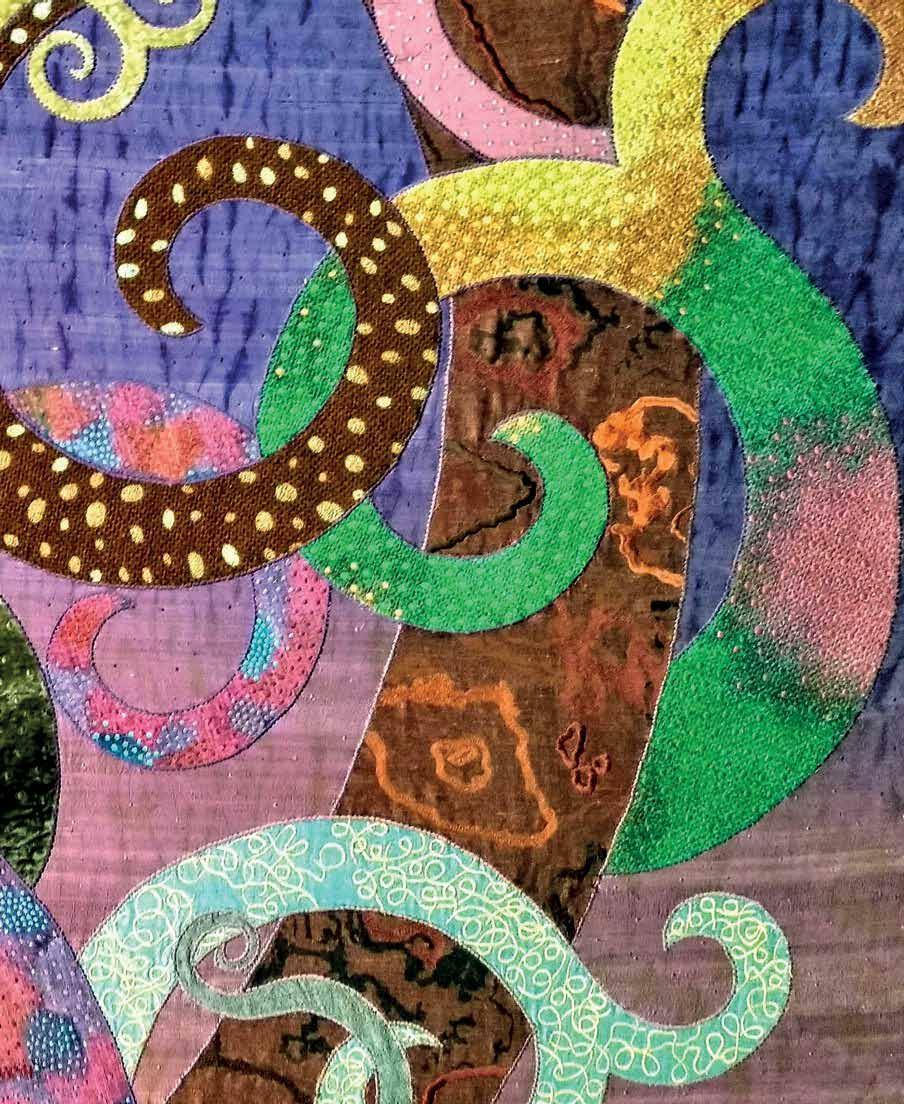
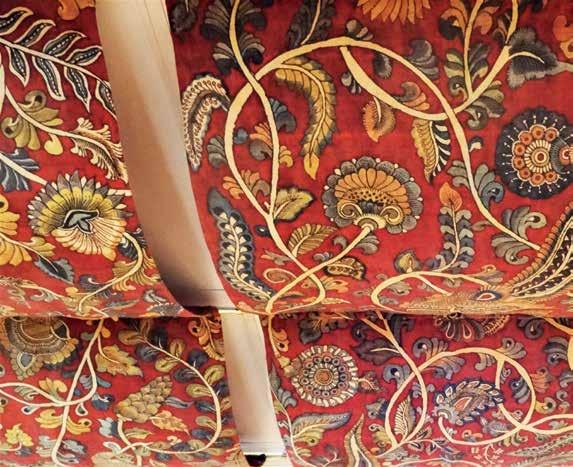
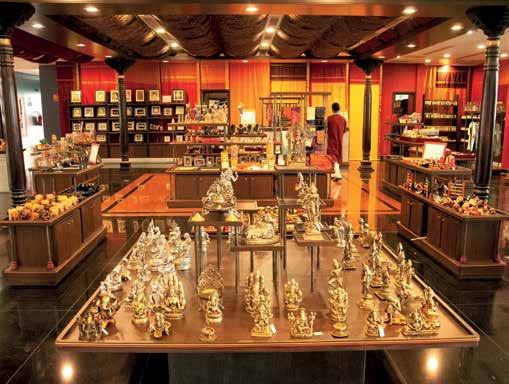
Kalamkari is a traditional technique of hand-painting fabric using organic dyes, practised in India mainly in the southern Indian states of Andhra Pradesh and Telangana, with the town of Srikalahasti being a major hub. Dyes are used in a runny consistency to paint lyrical forms on fabric. Popular themes include narratives from mythological epics as well as motifs drawn from nature.
Inspiration: The client operates a flagship airport store showcasing traditional art and craft products from southern India. Hence, the use of kalamkari for a textile canopy created an artistic synergy with the language of the store. The canopy was created using 49 panels, each of 2m x 1m dimension. Inspired by local flora and fauna, the pieces use earthy natural dyes. Further,
the cascading panels feature extensive, intricate artwork, and create impactful perspectives.
Sustainability: The materials are handwoven fabrics of cotton and silk, and dyes derived from natural ingredients that are free of chemicals. By showcasing the craft and the communities involved, in the middle of a bustling airport, such design interventions help create sustainable livelihoods.
Material: Fabric, organic dyes Technique: Kalamkari painting

Craftsperson(s): Traditional artists from the kalamkari -based NGO Dwarka, Bengaluru. Source Region: Andhra Pradesh, India Studio: Siddhartha Das Studio
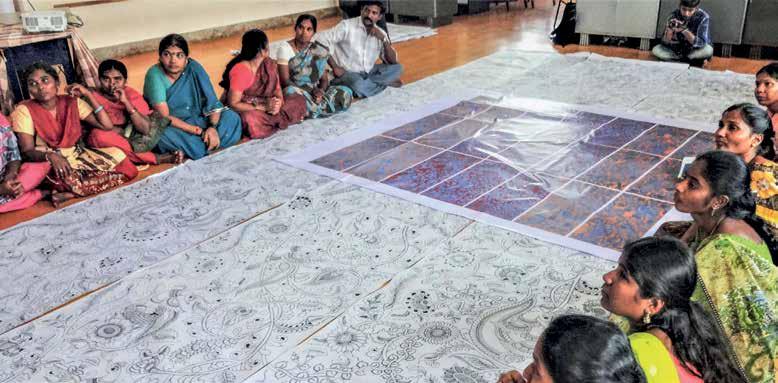
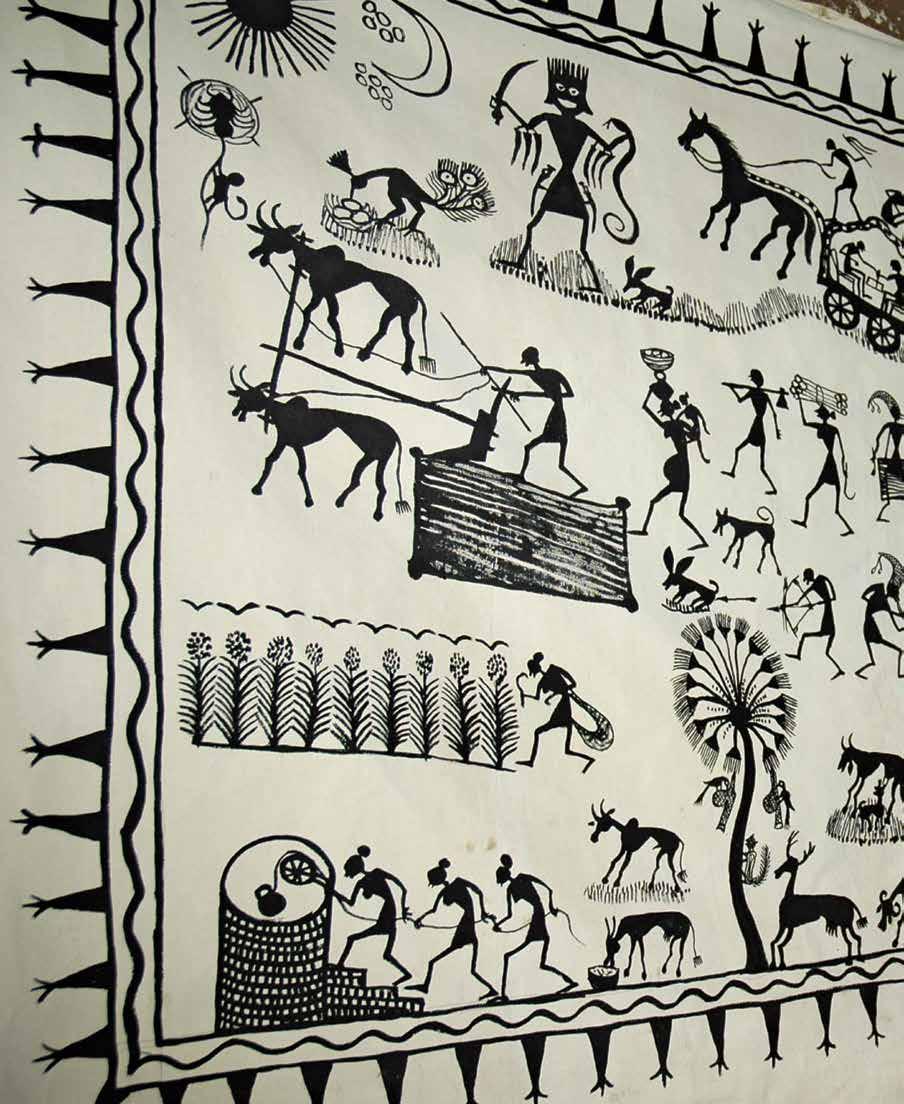

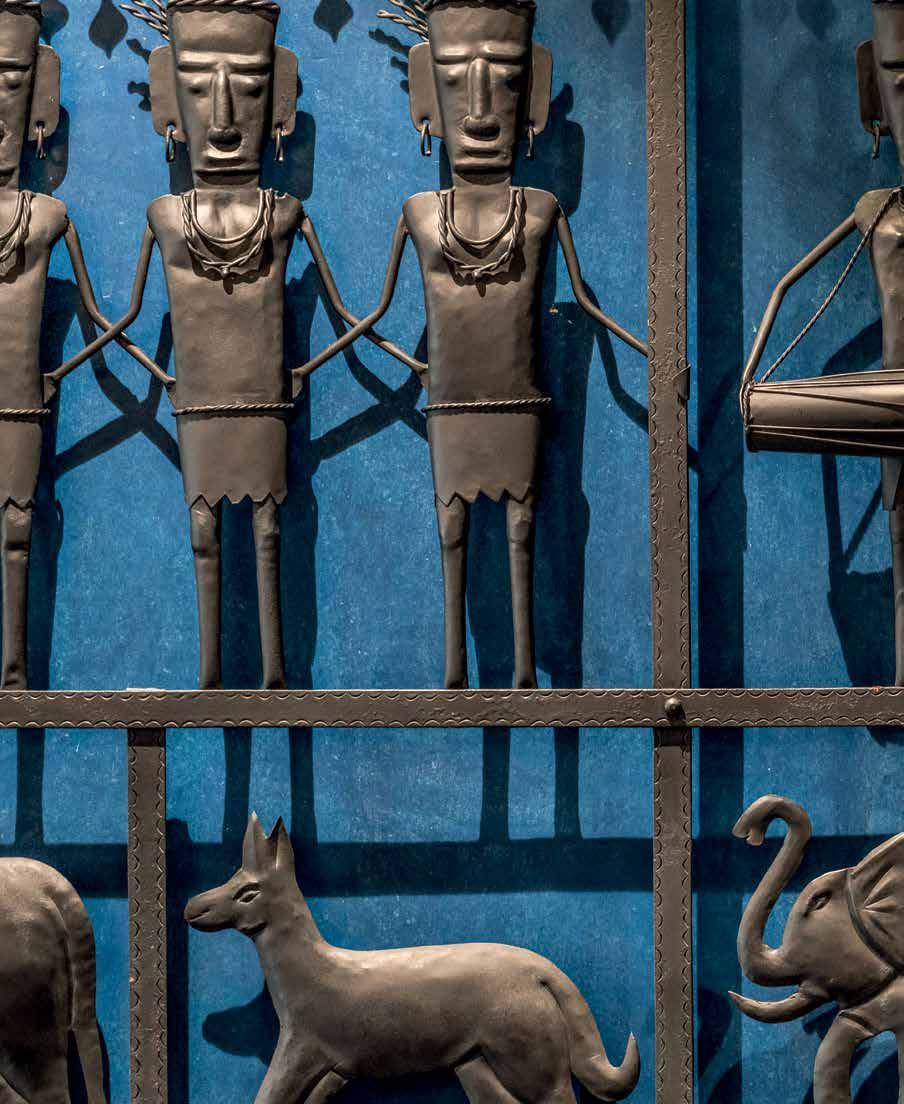
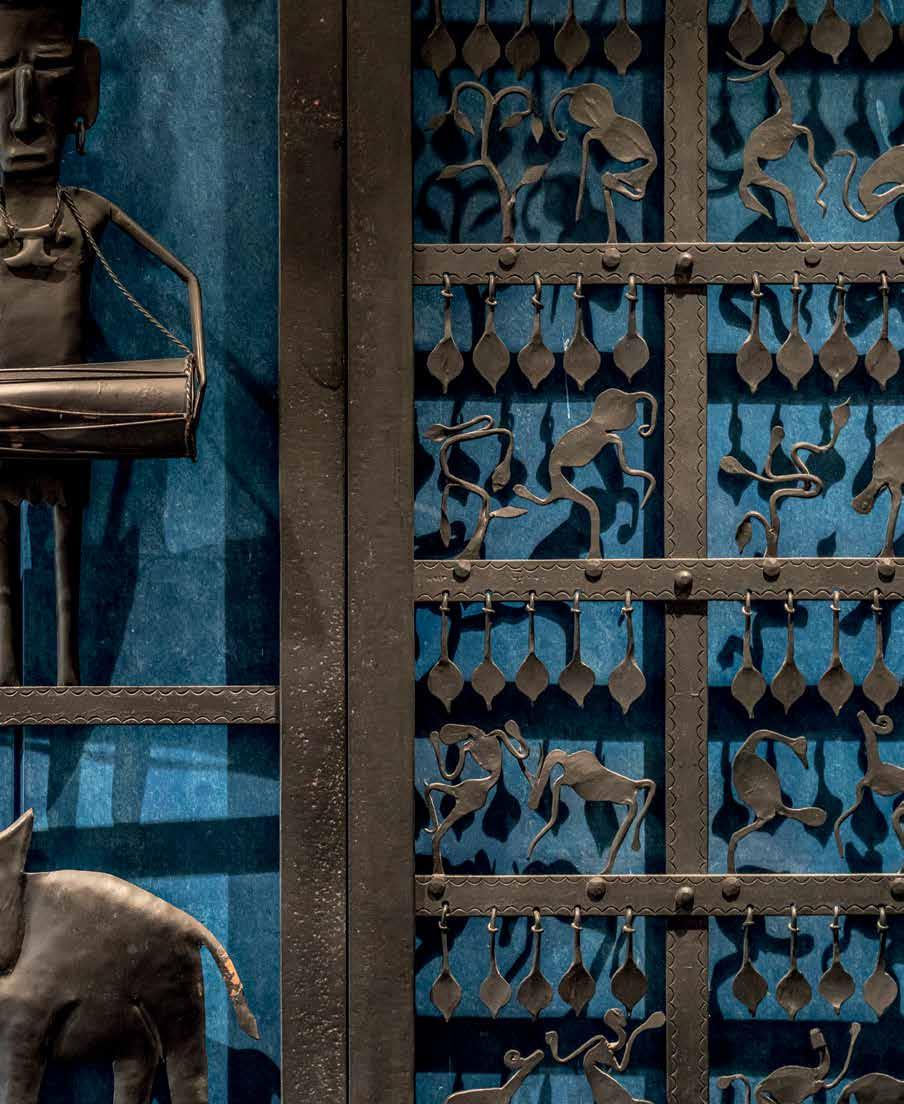
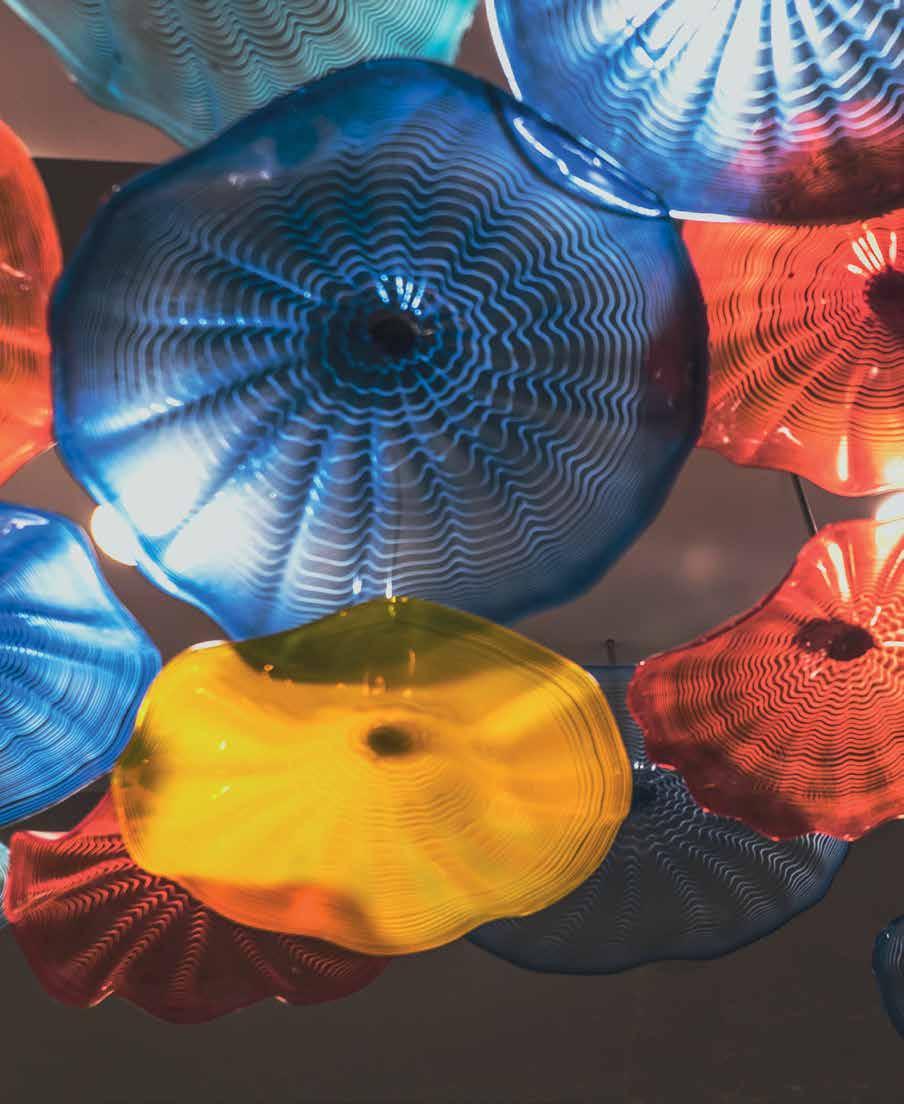

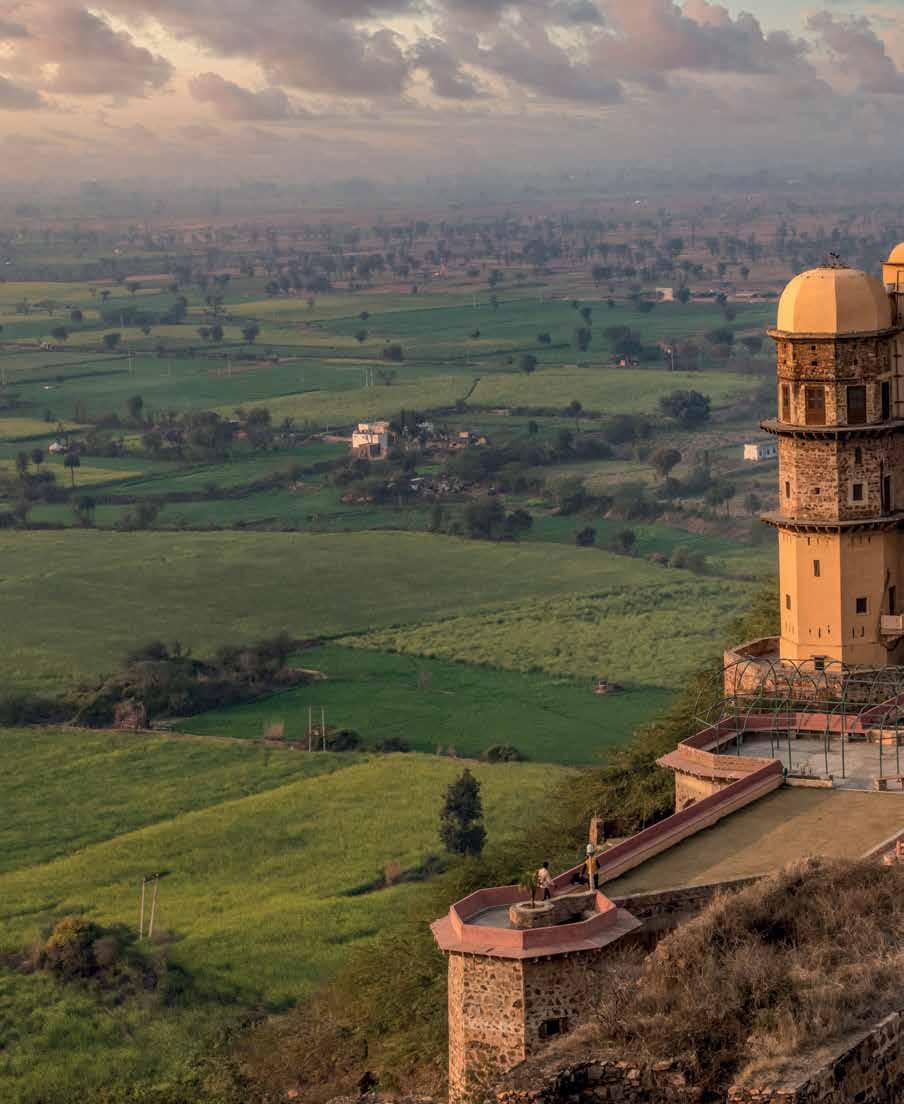

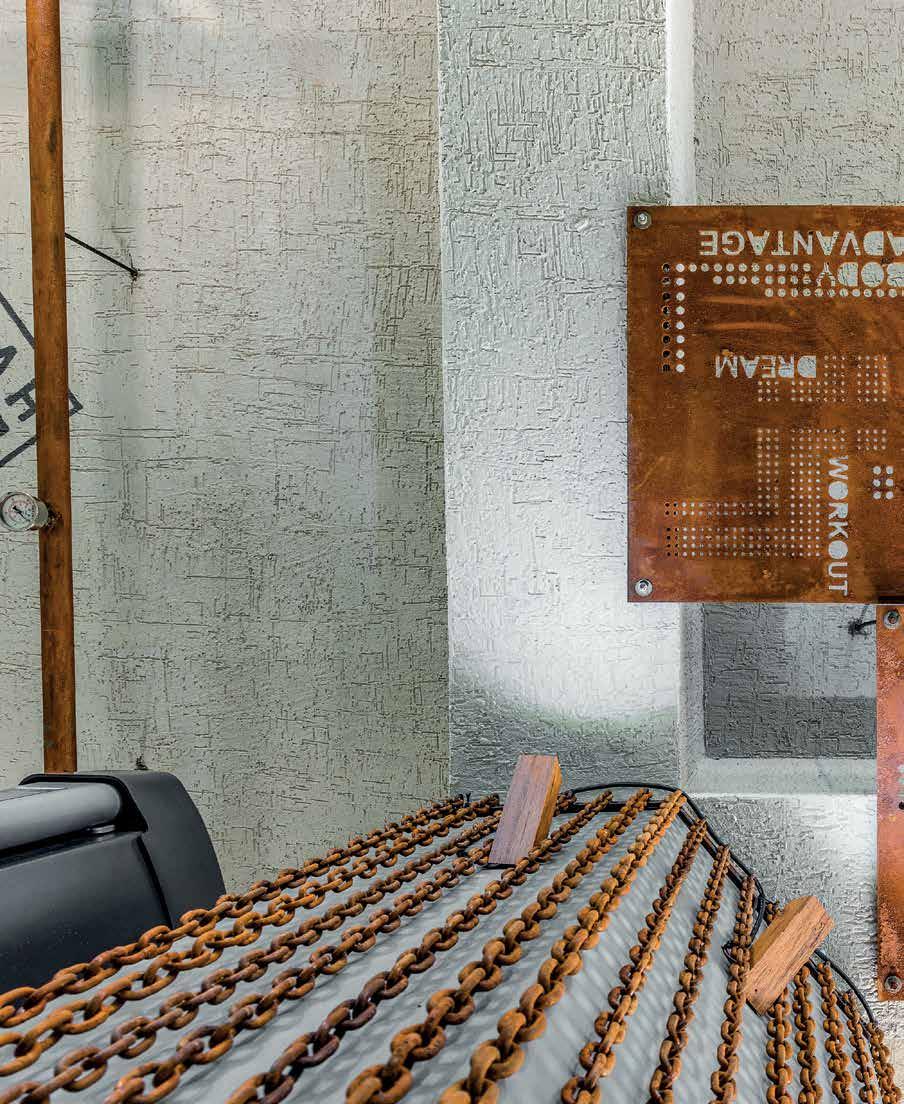
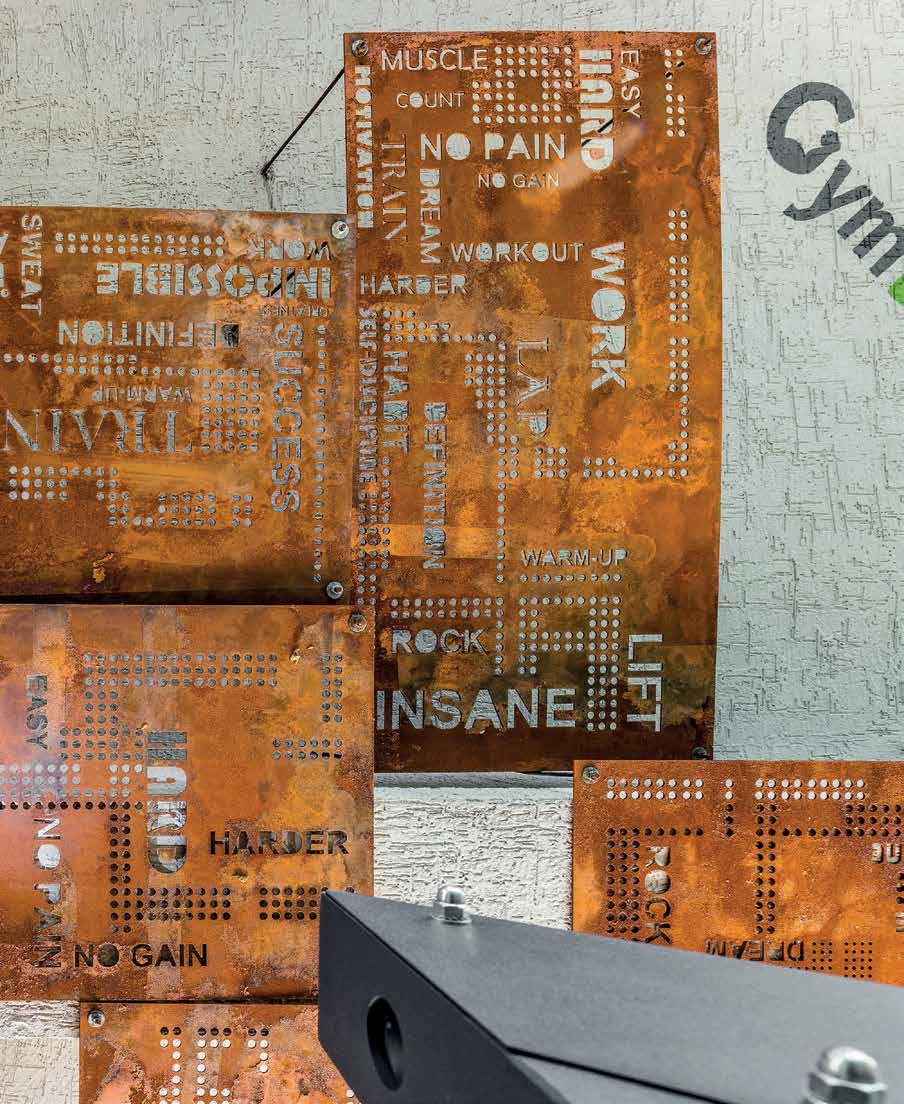
Depicting the ten unique incarnations of Lord Vishnu, this brass design of the dashavatar used the traditional dhokra lostwax casting technique. The process involved intricate patterns that were generated with wax threads (with custom-made convex) and then replaced with hot molten brass, poured into moulds. The recycled brass was locally sourced. Wax for the moulds was prepared using a reusable mixture of paraffin, beeswax, tar and camphor. The clay used was sourced from Chhattisgarh and mixed with rice husk. Hence, the project used organic, biodegradable materials keeping in mind the benefits of the same as opposed to largescale industrial procurements. The designs were conceptualized and executed under the guidance of the architect Shimul Kadri and Team Baaya.

Material: Metal Technique: Dhokra, or lost-wax casting

Source Region: Chhattisgarh, India Studio: Baaya Design
Tholu bommalata, a form of traditional leather puppetry, is a heritage craft from Andhra Pradesh and Telangana, narrating mythological tales with majestic, handcrafted leather puppets that dance against a backlit screen to a folk chorus. These lamps and light fixtures have been created using the traditional craft of leather puppetry in a contemporary mode. The parchment leather, which is the canvas of this craft, is sized and carefully stitched onto the metal frame. The drawings are then marked on it with a bamboo pen and coloured with drawing inks, all by hand. The artisans
who worked on these products, D. Chinnarammana and his son Venkatesh, have a long multigenerational involvement in this craft. The tiny holes made after finishing the product add grandeur to the light once lit. The translucent nature of parchment leather makes it a very interesting material to explore the play of light around it. The leather used is sourced as waste from the food industry and given a new form.
Material: Parchment leather Technique: Tholu bommalata, or leather puppetry
Craftsperson(s): D. Chinnarammana and Venkatesh
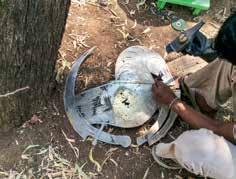
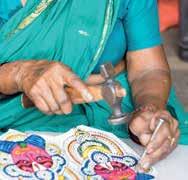
Source Region: Andhra Pradesh, India
Studio: Studio Moya
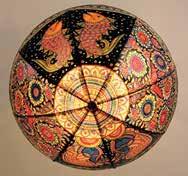 Studio Moya Material: Parchment leather
Baaya Design, Material: Metal
Studio Moya Material: Parchment leather
Baaya Design, Material: Metal
Kutch
Chamba
Dharamshala
Srinagar Leh Dehradun
Amritsar Rohtak
Shimla
Nainital
Pauri Garhwal Haldwani
Jhajjar
DADRA
Mumbai
Moradabad Ghaziabad Pali
Rajsamand ChittorgarhUdaipur
MandsaurPratapgarh
Ahmedabad
Jamnagar Pune Thane
Bikaner Alwar Jaisalmer Khambhat Vadodara
Agra Firozabad
Bareilly
Lucknow Jaipur
Barabanki
Banda Bhadohi
Gangtok Patna
Panchmahal
Hoshiarpur Ropar Surat
Silvassa (DAMAN & DIU)
Anantnag Aurangabad
Gandhinagar Bhopal Raipur Hyderabad
Panaji
Kavaratti
Raigarh
Azamgarh Darbhanga Bankura Bargarh
Jalgaon Dhenkanal
Itanagar Shillong
Dispur
Phek District
Kohima
Ukhrul
Ranchi Bhubaneshwar
Varanasi Birbhum Bastar
Srikakulam
Etikoppaka
Agartala
Tripura West Hooghly
Kolkata
Murshidabad Burdwan West Midnapore
Imphal Aizawl
Dhubri Golaghat Howrah Cuttack
JagatsinghpurKhurda
Assam
Punjab
Bengaluru
Chennai
Visakhapatnam Warangal Cheriyal Bidar Channapatna Mysuru
Manipur
Goa
Vellore
Thiruvannamalai Chengalpattu Kancheepuram Vanur
Alankuppam
Thanjavur
Bicholim Margao Kalady Thrissur Aranmula Karaikudi Athangudi
Pathanamthitta
Thiruvananthapuram
Kanyakumari
SRI LANKA
Chhattisgarh
Telangana
Port Blair
First published in 2022 by Mapin Publishing Pvt. Ltd 706 Kaivanna, Panchvati, Ellisbridge, Ahmedabad 380006 Gujarat, India and
Institute of Indian Interior Designers (IIID)
109 Sumer Kendra Pandurang Budhkar Marg Worli, Mumbai 400018 Maharashtra, India
© Institute of Indian Interior Designers (IIID) and Mapin Publishing, 2021
All rights reserved.
Text © Authors
Photographs © as listed
For all individual entries from designers/design studios, photographs have been reproduced with permission from the respective entries.
The moral rights of Jaya Jaitly, Aman Nath, Asha Sairam, Kristine Michael, Neelam Chhiber, Rebecca Reubens, A. Balasubramaniam, Mitchell Abdul Karim Crites, Ayush Kasliwal and Arjun Rathi as authors of this work are asserted.
ISBN: 978-93-85360-94-7
Copyediting: Mithila Rangarajan / Mapin Editorial
Proofreading: Ateendriya Gupta, Neha Manke / Mapin Editorial
Design: Gopal Limbad / Mapin Design Studio
Production: Mapin Design Studio
Printed in China
front cover : The reception area for a Delhibased office features a vivid backdrop of paper cutouts of Delhi’s architectural landmarks and fauna. These were executed by master craftsman Ram Soni using the delicate but impactful sanjhi technique, in association with artisans from Dastkari Haat Samiti. (See pp. 76–77)
page 1: A partition wall in jali style made of locally-sourced laterite and khondalite (sandstone) at Krushi Bhawan in Bhubaneswar. (See pp. 30–31)
pages 2–3: Canopy made of jute ropes provides a way to manipulate sunlight and air at this rooftop cafe in Ahmedabad. (See pp. 74–75)
pages 4–5: A suite at the Tijara Fort heritage hotel features a large frescoed wall along with the decor in the seating area bringing in the mela atmosphere of a village fair. (See pp. 212–217)
page 6: An accent wall created using lippan kaam and aabhla work at a residence in Gujarat. (See pp. 164–165)
back cover: This stunning, unusual hanging lamp, designed by Ankon Mitra and Neha Bhardwaj, is made of hand-folded parchment leather and knitted wool. It brings together Indian and Japanese craft techniques to create a product that uses traditional materials within a modern design. (See pp. 140–141)
A.Balasubramaniam is a product designer based in Gurgaon, India. He is the Founder of January Design, a design consultancy that works mainly with marginal crafts, grass-roots innovations and the MSME sectors of the industry. An early graduate of the National Institute of Design, Ahmedabad, he is currently the Director of the Institute of Design at J.K. Lakshmipat University, Jaipur. He regularly writes on design issues in major publications, as well as his own blog, Design Thoughts
Aman Nath is an Indian writer, hotelier and architectural restorer. One of the founding members of INTACH, he is the Co-founder and Co-chairman of the Neemrana Hotels chain. He is also the author of numerous books, including Arts and Crafts of Rajasthan, with Francis Wacziarg (Mapin, 1997).
Arjun Rathi is an architect and lighting designer and the Founder of Arjun Rathi Design. Established in 2011, his work has gained national and international recognition for its exploratory approach to design processes.

Asha Sairam is a Design Principal at Studio Lotus. Part of this pioneering studio since 2010, she heads teams in articulating brands to the built environment from concept to detail and uses her diverse experience across verticals to shape definitive projects at the practice.
Ayush Kasliwal is the Creative Director and Co-founder of AKFD and Anantaya, based in Jaipur, India. Their works have been recognized through several awards, including the LEXUS Design Award 2019; AD 100; the Kyoorius Design Award 2019; and the EDIDA award 2018, 2017, 2013.
Jaya Jaitly established the Dastkari Haat Samiti in 1986. Her pioneering work in the field of crafts includes innovative design and marketing strategies, including bringing together the diverse craftspeople of South Asia, the Middle East and Africa. She has written prolifically on Indian arts, crafts and textiles. Among her works are Crafts of Jammu, Kashmir and Ladakh (Mapin, 1999) and the seminal Crafts Atlas of India
Kristine Michael is a ceramic artist, curator and writer based in New Delhi. She is also an arts educator and currently holds the position of Curriculum Leader of Visual and Dramatic Arts at The British School in New Delhi. She was most recently a contributor to the book Mutable: Ceramic and Clay Art in India Since 1947 (Mapin, 2021).
Mitchell Abdul Karim Crites has spent his life studying, preserving and reviving the great art forms of the Islamic world. He is the author of the best-selling India Sublime. among others. His current projects include the world’s longest monumental calligraphic marble panels, inlaid with lapis lazuli, for the important Al-Shamiya Extension project in Mecca Sharif.
Neelam Chhiber, an award-winning social entrepreneur, is Co-founder and Managing Trustee at Industree Crafts Foundation. An Industrial Design graduate from NID, Ahmedabad, she has for the past three decades been working with artisans in rural areas, by providing design, technical, marketing and management solutions to bridge the urban-rural chasm.
Rebecca Reubens works at the intersection of design, craft and sustainability. Her PhD at the Delft University of Technology focused on the links between sustainability, design, craft and development. She is the author of the books Bamboo: From Green Design to Sustainable Design, and Holistic Sustainability Through Craft-Design
